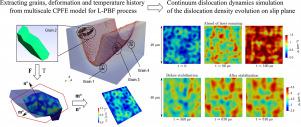Journal of the Mechanics and Physics of Solids ( IF 5.0 ) Pub Date : 2023-02-09 , DOI: 10.1016/j.jmps.2023.105235 Daijun Hu , Nicolò Grilli , Wentao Yan

|
The motion of dislocations governs the plastic deformation of crystalline materials, which in turn determines the mechanical properties. The complex thermal history, large temperature gradients and high cooling rates during the process of additive manufacturing (AM) can induce high dislocation density and unique dislocation structures in the material. The origin of these dislocation structures and their stability during mechanical loading are debated. A novel temperature dependent continuum dislocation dynamics (CDD) model is developed, in which four state variables are used for each slip system representing the total dislocation density, edge and screw geometrically necessary dislocation densities and dislocation curvature. The CDD model is fully coupled with a crystal plasticity solver, which captures the plastic deformation induced by the dislocation motion. A hybrid continuous and discontinuous Galerkin formulation is developed to accurately reproduce the dynamics of highly discontinuous dislocation density fields that are typical of dislocation structures. A multiscale modeling approach is used, in which the thermally induced deformation in specific grains of a polycrystal is extracted from larger scale crystal plasticity simulations of the laser powder-bed fusion process, and is then used for single crystal scale dislocation dynamics simulations. Simulation results reveal the dynamics of dislocation structure formation in grains at different positions during laser scanning and cooling stages. The effect of the cyclic thermal stress during multi-layer AM fabrication is also investigated. The simulations provide a new perspective on the specific conditions that should be satisfied during AM process for the formation of stable dislocation structures.
中文翻译:

增材制造中热应力引起的位错结构形成:位错传输的多尺度晶体塑性建模
位错的运动控制晶体材料的塑性变形,进而决定机械性能。增材制造 (AM) 过程中复杂的热历史、大的温度梯度和高冷却速率会导致材料中产生高位错密度和独特的位错结构。这些位错结构的起源及其在机械加载过程中的稳定性存在争议。开发了一种新的温度相关连续体位错动力学 (CDD) 模型,其中四个状态变量用于每个滑移系统,代表总位错密度、边缘和螺旋几何必要位错密度和位错曲率。CDD 模型与晶体塑性求解器完全耦合,它捕获由位错运动引起的塑性变形。开发了一种混合连续和不连续的伽辽金公式,以准确再现位错结构典型的高度不连续位错密度场的动力学。使用多尺度建模方法,其中从激光粉末床熔合过程的更大规模晶体塑性模拟中提取多晶特定晶粒的热诱导变形,然后用于单晶尺度位错动力学模拟。模拟结果揭示了激光扫描和冷却阶段不同位置晶粒中位错结构形成的动力学。还研究了多层 AM 制造过程中循环热应力的影响。











































 京公网安备 11010802027423号
京公网安备 11010802027423号